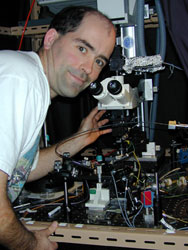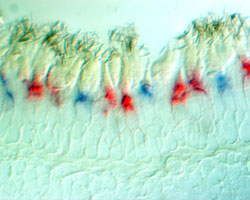 |

For further information, contact the MBL Communications Office at (508) 289-7423 or e-mail us at comm@mbl.edu
For Immediate Release: March 18, 2008
Contact: Gina Hebert, 508-289-7725, ghebert@mbl.edu
 |
 |
|
|
Color-vision researcher Iñigo Novales Flamarique, Ph.D., of Simon Fraser University (SFU), British Columbia, Canada, is the first recipient of the Grass-MBL Sabbatical Fellowship in neuroscience.
|
|
The Science of Seeing in Color
Winner of Grass-MBL Sabbatical Fellowship Award Arrives
MBL, WOODS HOLE, MA—Color-vision researcher Iñigo Novales Flamarique, Ph.D., of Simon Fraser University (SFU), British Columbia, Canada, is the first recipient of the Grass-MBL Sabbatical Fellowship in neuroscience.
Novales Flamarique arrives at the MBL (Marine Biological Laboratory) on April 1 to conduct sabbatical research throughout the spring.
Novales Flamarique, an associate professor in the Department of Biological Sciences at SFU, studies the cones of the retina, which enable color vision. During his spring sabbatical period, he will be collecting killifish (Fundulus heteroclitus) at various life stages, from recently hatched through adult, to determine the role of thyroid hormone in triggering changes in the cone photoreceptors of this animal as it matures.
Novales Flamarique’s work builds on fundamental discoveries in color vision by Nobel Prize-winner George Wald, an MBL investigator from 1934 through the early 1970s. Wald determined that each cone of the animal retina absorbs light in a certain range of the visible spectrum, which is determined by which opsin (visual pigment protein) is prevalent in the cone. For decades it was assumed that a cone’s “spectral phenotype” remained unchanged throughout the animal’s lifetime. Yet, in 2004, Novales Flamarique and Christiana L. Cheng showed that in the Pacific pink salmon (Oncorhynchus gorbuscha), single cones switch their spectral phenotype from ultraviolet to blue by regulating the production of the appropriate opsins as the fish grows older. This photoreceptor plasticity, they proposed, may operate to modulate color vision as the salmon’s lifestyle changes and it moves from surface waters, where ultraviolet light is abundant, to a habitat in deeper waters, where blue-green light prevails.
During his MBL sabbatical, Novales Flamarique will investigate the role of thyroid hormone in triggering opsin switches in the maturing killifish. In the retinas of rodents and humans, thyroid hormone has been shown to activate the expression of medium-wavelength opsins (green/red) in cones that would otherwise express short-wavelength opsins (ultraviolet/blue). But it is unknown whether this expression occurs as a result of opsin switches within cones, or due to the appearance of new cones. The killifish is an excellent model system for studying this question, Novales Flamarique says, because the “mosaic” arrangement of cones in the fish retina allows for an easier spatial assessment of opsin expression than does the non-mosaic cone arrangement of higher vertebrates.
 |
 |
|
|
|
Radial section through the outer retina of a juvenile rainbow trout showing single cones that express opsins maximally sensitive to ultraviolet light (SWS1 opsin, labeled in red) or blue light (SWS2 opsin, labeled in blue). In salmonid fishes, single cones switch opsin expression from ultraviolet to blue during the juvenile period, and this may also occur in most other animals including mammals. Dr. Novales Flamarique's research investigates the transcriptional factors that regulate this switch, including the role of thyroid hormone, the subject of his research on the killifish in Woods Hole.
|
Although the $30,000 Grass-MBL Sabbatical Fellowship award is new in 2008, The Grass Foundation has a long history of supporting neuroscience research and education at the MBL. The late Albert and Ellen Grass, founders of the Grass Instrument Company, makers of scientific instrumentation, launched the Grass Fellowship Program at the MBL in 1951. Each summer, about 12 early-career investigators in neuroscience spend 14 weeks at the MBL as Grass Fellows. (Novales Flamarique was a Grass Fellow in 1995.) The Foundation also sponsors The Albert and Ellen Grass Faculty Grant Program, which enables collaborative research in neuroscience at the MBL by two or more investigators; and the Forbes Lectures, two evening lectures given each summer by high-profile scientists in the field. The Grass Foundation generously provides partial support for several MBL summer courses: Neurobiology; Neural Systems and Behavior; and Neural Development and Genetics of Zebrafish.
The MBL is a leading international, independent, nonprofit institution dedicated to discovery and to improving the human condition through creative research and education in the biological, biomedical and environmental sciences. Founded in 1888 as the Marine Biological Laboratory, the MBL is the oldest private marine laboratory in the Western Hemisphere. For more information, visit www.MBL.edu.
|